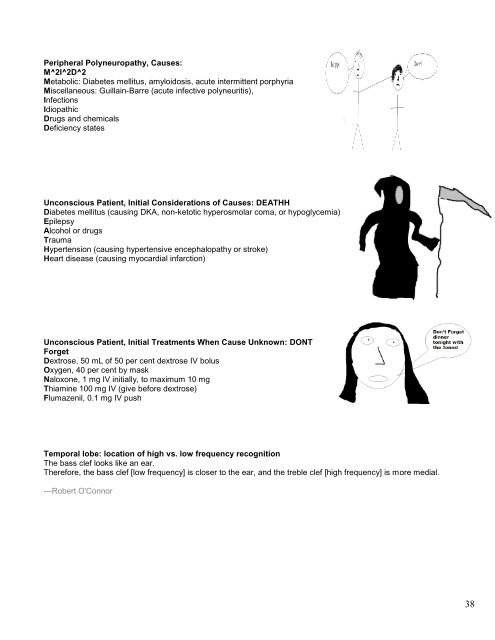Medical Mnemonics
mapped-medical-mnemonics
mapped-medical-mnemonics
Create successful ePaper yourself
Turn your PDF publications into a flip-book with our unique Google optimized e-Paper software.
Peripheral Polyneuropathy, Causes:<br />
M^2I^2D^2<br />
Metabolic: Diabetes mellitus, amyloidosis, acute intermittent porphyria<br />
Miscellaneous: Guillain-Barre (acute infective polyneuritis),<br />
Infections<br />
Idiopathic<br />
Drugs and chemicals<br />
Deficiency states<br />
Unconscious Patient, Initial Considerations of Causes: DEATHH<br />
Diabetes mellitus (causing DKA, non-ketotic hyperosmolar coma, or hypoglycemia)<br />
Epilepsy<br />
Alcohol or drugs<br />
Trauma<br />
Hypertension (causing hypertensive encephalopathy or stroke)<br />
Heart disease (causing myocardial infarction)<br />
Unconscious Patient, Initial Treatments When Cause Unknown: DONT<br />
Forget<br />
Dextrose, 50 mL of 50 per cent dextrose IV bolus<br />
Oxygen, 40 per cent by mask<br />
Naloxone, 1 mg IV initially, to maximum 10 mg<br />
Thiamine 100 mg IV (give before dextrose)<br />
Flumazenil, 0.1 mg IV push<br />
Temporal lobe: location of high vs. low frequency recognition<br />
The bass clef looks like an ear.<br />
Therefore, the bass clef [low frequency] is closer to the ear, and the treble clef [high frequency] is more medial.<br />
---Robert O'Connor<br />
38



